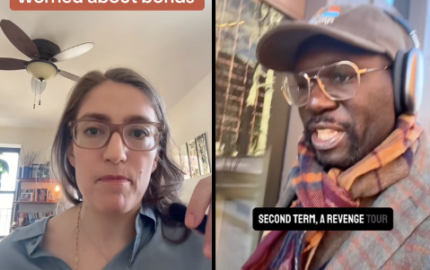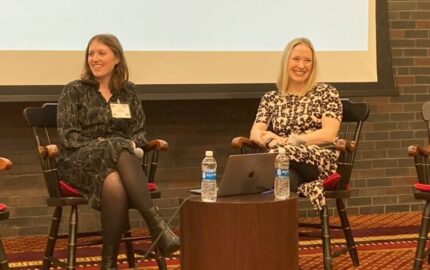I was asked to do something very familiar to lovers of All Things Nieman: "Give readers a sense of how you can use podcasts to do true narrative that includes elements of classic storytelling (introduces characters, makes use of scenes, or immerses listeners in not just sound bites but a story)."
After much typewriting (nod to Truman Capote), I realized that this is just... not... my... thing. There are plenty of good purveyors of this advice in the public radio world already. They give seminars and talks. They have staff. They have marketing teams, nice hair and therefore aspirations to television careers. They win awards, and even have time to accept them.
I have none of that, but especially not the time or the hair (these may not be unrelated). So, I'm going to do the only valuable thing that 14 years of daily deadline journalism have taught me. Quit fighting the assignment, turn the damn thing on its head, and see what happens...
Great radio does not equal great podcasting. There, I said it.
Let me explain. All of those wonderful things I was asked to talk about above? They do make for great radio. More specifically, they make for great long-form, narrative radio. That's the kind of radio many of us dreamed of doing when we started the business, before so much of it, for reasons both economic and stylistic, became four and a half minute chunks of airtime filled with cribbed wire copy and bad phone tape. Both the great radio and the mediocre get turned, often auto-magically, into mp3 files. Those files are then shoved up on a server somewhere for you to download to your PodBerry or whatever.
And this, they will tell you, is podcasting. Or maybe they'll be a little more truthful and call it "time-shifted" radio. I sometimes call it "recycled" radio.
Don't get me wrong. Recycling is good for the audio planet. It's great that you can stuff hours of potentially quality stuff onto a minuscule machine, encase it in a sweat-proof nano-sheath, and then listen to Diane Rehm while climbing Mount Kilimanjaro. (Remember, the p-o-d in podcasting stands for "Portable On Demand.")
But that's it? Seriously? That's all we are going to do with this amazing new medium for engaging unsuspecting audiences in unexpected ways?
When I started producing a weekly technology podcast four and half years ago, I wanted to take a different approach. Not radically different, but different. Sure, I wanted to base the podcast around technology stories I had been working on for the show, but I did not just want to run those pieces one after another without doing all those narrative tricks that help create a more cohesive, and above all more personal, listening experience.
First, I decided to host the podcast myself. At the time, nobody knew what a podcast was, so nobody stopped me. The first few episodes were, as you can imagine, rough. But I quickly learned some tricks. Podcast listeners engage with the material in a radically different way than broadcast listeners. My podcast audience, for example, is much more engaged with the technology content. That means I could tell the stories differently, and go places that I couldn't on the broadcast. And that's when the second big revelation hit me: the time limits of radio were gone.
I experimented. I started including longer versions of interviews that I had done for the radio pieces, going into greater depth with the subject matter. That proved popular with listeners. I shunned the original overly scripted leads and instead opted to make the intros more personal and more in-depth. As I recorded my intros, I would think to myself: you're sitting at the bar, and the person next to you asks, "So, what are you working on? Why?" Listeners loved that too. I started to get emails saying, "The thing I love most about your podcast? I feel like you're having a conversation with me, not talking at thousands of other listeners."
Bingo. That's solid gold to those of us who care about audio storytelling, because it means the listeners are really engaged with the tale we're telling. They're taking it personally. So personally that they started suggesting original ideas for interviews, segments and stories without being prompted. Soon, I realized that every podcast episode should have a podcast-exclusive interview, preferably one suggested by listeners.
In fact, I now like to say that the podcast is as much the listeners as it is mine. I've even started a new series focused on tech podcast listeners and the amazing jobs or hobbies they have. Talk about some natural storytellers! All I have to do is remember to just stay out their way as much as possible.
So, is this great podcasting?
Who knows?
I do know that others here at The World have taken my lead, and are producing some quite original online work that combines all of the elements of great storytelling with the best in beat reporting. Just check out my colleague Jeb Sharp's podcast, called "How We Got Here." Each week, she takes an in-depth look at the history behind the international news headlines. Also, Patrick Cox does an original podcast on global language that's really worth a listen. It's called "The World in Words."
"So what?” you say. “What's so big about a few disgruntled hacks who get a big head, and decide they can host their own revue shows off Off-Broadway style?"
Well, if you're a public radio listener, you might just be hearing more of that informal style and content. Podcasters here at The World are now actively contributing what was once considered only "podcast material" to the Big Show. Apparently, the show’s producers like the tone we're striking in our podcasts, and find the content "quirky, yet compelling."
So maybe, in a real twist, recycled podcasts are now making great radio?
Well, let's not get ahead of ourselves. I will say this: here at The World, the feeling among the podcasters themselves is that the process of creating these different kinds of audio offerings is making us more creative storytellers. Our pieces for the show are increasingly written in ways other than the standard “read copy/play tape/read copy/play tape” format. (For someone else bucking the trend, sometimes beautifully, check out Nate DiMeo’s podcast, called “the memory palace.”)
That's a direct result of having space in the audio sandbox to play around a bit. It’s strange, and a bit sad, to think that some of the finest audio storytellers aren’t taking more advantage of the freedom that sandbox can offer. I even hear things like “podcasting is so 2006.” We make great radio, the thinking goes, so just let the software slap the audio online and be done with it.
Sure, it’s easy, in the same way that the Dark Side of the Force is easy.
The truth is that audio storytellers who do that are missing a great opportunity. And the void that is left is being filled by print and pixel outlets such as Slate, The Guardian and The Economist. Which are, ironically, some of the best places for creative audio storytellers to look for work these days.
Clark Boyd covers technology stories for Public Radio International’s The World and was a 2006-07 Knight Fellow at the Massachusetts Institute of Technology. Each of his weekly podcasts averages 50,000 to 60,000 listeners per month.
 Both the great radio and the mediocre get turned, often auto-magically, into mp3 files. Those files are then shoved up on a server somewhere for you to download to your PodBerry or whatever.
And this, they will tell you, is podcasting. Or maybe they'll be a little more truthful and call it "time-shifted" radio. I sometimes call it "recycled" radio.
Don't get me wrong. Recycling is good for the audio planet. It's great that you can stuff hours of potentially quality stuff onto a minuscule machine, encase it in a sweat-proof nano-sheath, and then listen to Diane Rehm while climbing Mount Kilimanjaro. (Remember, the p-o-d in podcasting stands for "Portable On Demand.")
But that's it? Seriously? That's all we are going to do with this amazing new medium for engaging unsuspecting audiences in unexpected ways?
Both the great radio and the mediocre get turned, often auto-magically, into mp3 files. Those files are then shoved up on a server somewhere for you to download to your PodBerry or whatever.
And this, they will tell you, is podcasting. Or maybe they'll be a little more truthful and call it "time-shifted" radio. I sometimes call it "recycled" radio.
Don't get me wrong. Recycling is good for the audio planet. It's great that you can stuff hours of potentially quality stuff onto a minuscule machine, encase it in a sweat-proof nano-sheath, and then listen to Diane Rehm while climbing Mount Kilimanjaro. (Remember, the p-o-d in podcasting stands for "Portable On Demand.")
But that's it? Seriously? That's all we are going to do with this amazing new medium for engaging unsuspecting audiences in unexpected ways?


